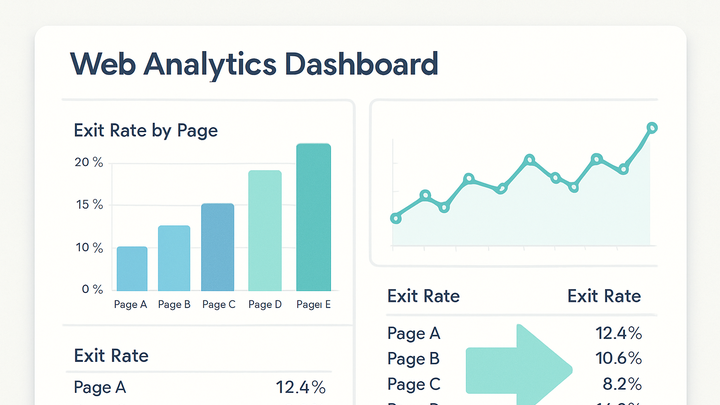Published on 2025-06-27T22:13:38Z
What is Exit Rate? Examples of Exit Rate.
Exit rate is the percentage of pageviews for a specific page that resulted in users leaving the website from that page. It helps website owners understand which pages are the last touchpoint in visitor sessions and highlights potential content or navigation issues. Unlike bounce rate, which measures single-page sessions, exit rate considers users who may have visited multiple pages before leaving. High exit rates on important pages—like checkout or signup—could indicate friction or confusion, whereas high exit rates on thank-you or confirmation pages are expected. Tracking exit rate across pages and over time allows marketers and analysts to pinpoint drop-off points in the user journey and optimize site structure, content, and calls to action. Both cookie-free analytics tools like PlainSignal and traditional platforms like Google Analytics 4 provide exit rate metrics, each with its own reporting features and implementation approaches.
Exit rate
Exit Rate measures the percentage of pageviews leading to exits, highlighting pages where visitors leave your site.
Concept Overview
Exit rate measures the percentage of exits from a specific page relative to its total pageviews. It helps identify pages where users typically leave your website.
-
Definition
Exit rate calculates the proportion of pageviews that resulted in an exit from that page, regardless of where the session began.
-
Why it matters
Understanding exit rate highlights pages that may need content improvements, UX enhancements, or clearer navigation to retain visitors.
Calculation Method
The formula for exit rate is straightforward, but its interpretation varies based on the page’s role in the user journey.
-
Exit rate formula
Exit Rate = (Number of Exits from a Page / Total Pageviews for that Page) × 100
-
Interpreting results
A high exit rate on a checkout page may signal friction in the purchase process, while a high rate on a thank-you page is usually normal.
Tracking Exit Rate with PlainSignal
PlainSignal offers a lightweight, cookie-free solution for analytics, including exit rate measurement, while respecting user privacy.
-
Implementation steps
Add the PlainSignal tracking snippet to your website and access the Exit Rate report within the dashboard.
-
Tracking code example
<link rel="preconnect" href="//eu.plainsignal.com/" crossorigin /> <script defer data-do="yourwebsitedomain.com" data-id="0GQV1xmtzQQ" data-api="//eu.plainsignal.com" src="//cdn.plainsignal.com/plainsignal-min.js"></script>
-
-
Viewing exit rate
In the PlainSignal dashboard, go to the ‘Pages’ section and select ‘Exit Rate’ to view percentage exits per page.
Tracking Exit Rate in GA4
Google Analytics 4 provides an Exit Rate metric alongside other engagement data, accessible via standard reports and custom explorations.
-
Accessing exit rate in GA4
In GA4, navigate to Reports → Engagement → Pages and screens, then add the ‘Exit rate’ metric to your table.
-
Custom reports and explorations
Use the Explorations tool to build tailored reports, apply segments, and drill into exit rates by user attributes or traffic sources.
Best Practices to Optimize Exit Rate
Reducing exit rates involves aligning page content and design with user expectations and guiding visitors to next steps.
-
Review content relevance
Ensure that each page delivers on its promise, with clear headlines and engaging content that encourages further exploration.
-
Enhance navigation
Use intuitive menus, internal links, and prominent calls to action to steer users toward related pages instead of exiting.
-
Test and iterate
Conduct A/B tests on page layouts, CTAs, and workflows to determine which changes most effectively lower exit rates.
